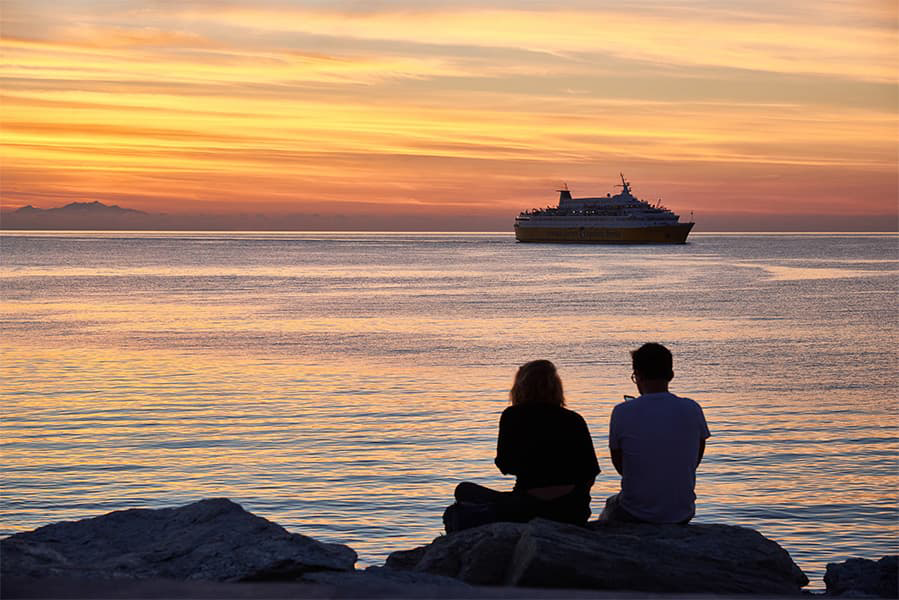Carmelo – Buenos Aires
Ferries to Argentina
Carmelo – Buenos Aires
Ferries to Argentina

At Direct Ferries we’re completely impartial and focused on helping you find the best fares on Carmelo Buenos Aires crossings between Uruguay and Argentina quickly and easily.
Use our Carmelo Buenos Aires ferry guide to find out all you need to know in order to book your ferry trip to Argentina including who sails on the Carmelo Buenos Aires route and if there are any other crossings on offer.
It’s quick and easy to get a ferry price! Simply select your place of departure from the Fare Search, Carmelo Buenos Aires from the route menu, number of people travelling and then just hit search.
More routes than anyone else.

Compare fares, times & routes in one place.
Change plans easily with flexi tickets.

Book e-tickets & manage trips in-app.
Live ship tracking & real-time updates.

Top-rated customer support when you need it.
Built on the angle of land between the great River Plate and the smaller Arroyo de las Vacas river is the town of Carmelo in the west of Uruguay. This South American settlement, most known for the thriving wineries found on the outskirts, is proud of its heritage as the only city founded by José Gervasio Artigas; a national hero often referred to as the ‘father of Uruguayan nationhood’. Carmelo’s neatly ordered grid of streets lead from the river-facing port in the south to the more rural farmland landscapes found along Route 21 in the north. The port is found on the north-side of the Arroyo de las Vacas river, just across a distinctive crimson-coloured steel bridge that spans the waterway. The ferry terminal here is nothing more than a departure point formed by a wide section of paving that lines the river bank. Due to the uniform road network in Carmelo, travelling to the harbour is simple. Motorists can enter the city via Route 21 which connects the city-centre to the collection of towns that can be found to the north and south. A bus service also travels into Carmelo from the larger city of Colonia del Sacramento and hour away. Only one passenger service currently operates from the port. A Colonia Express line sails to the sprawling Argentinian capital of Buenos Aries that sits on the opposite bank of the River Plate. It’s a short southbound trip along the country border that leaves the harbour multiple times throughout the day.
The city of Buenos Aires, located on the western shores of the vast River Plate estuary, is the largest city and capital of Argentina. It’s a multicultural metropolis that has retained much of its historical European identity, evident in the downtown clash of architecture that ranges from the soaring towers of the central business district to the pink walls of the Italianate-style Casa Rosada presidential palace. The ferry port of Buenos Aires is found to the north of the main collection of piers and shipping yards found in the Retiro borough of the city. The terminal here is set along the grass-lined banks of the Lujan river that flows into the larger River Plate, just to one side of a large man-made marina. A waiting area can be found inside the building and a limited number of car-parking spaces are available along the road into the harbour . Just a few minutes’ walk from outside the port entrance is the Marina Nueva train station that offers routes deeper into the suburbs of Buenos Aires, including a stop by the city’s international airport on the coast. The extensive National Route 9 highway, just a few minutes’ drive from the port, cuts north and connects motorists to other major Argentinian cities including Rosario and Cordoba. Passenger routes run from the port multiple times throughout the week, serviced by Buquebus and Colonia Express ferries. Both these lines offer daily routes to the nearby capital of Montevideo in Uruguay, a short distant across the River Plate, and the smaller Uruguayan city of Colonia Del Sacramento. Colonia Express also sails to the port-town of Carmelo a number of times per day.